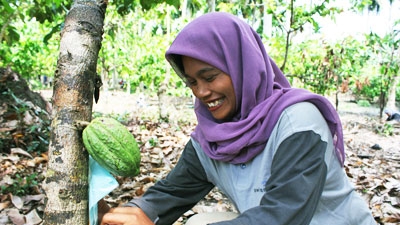A similar approach was used elsewhere in Bireun district by Sjamsul Bachri, a former combatant now living his new life as a cocoa farmer after peace settled in Aceh in 2006. The training program from Swisscontact even inspired Sjamsul to write his own a guidebook on how to rehabilitate and preserve cocoa plantations. In his book, Sjamsul combined methods he learned from Swisscontact’s training with results from his own experiments in the field. Amazingly, Sjamsul published this book out of his own pocket and gave it away to other farmers for free, in hopes that this would inspire them to go back to farming and make cocoa a local commodity.
Sjamsul and Anita are just two of many local farmers that hope to one day see Aceh’s cocoa potential evolve into a global industry. Both were trained at Swisscontact’s Cocoa Farmers Field School, have since become facilitators under this program. Both actively encourage members of their community to sign up for the same training program under their tutelage. Anita for example, leads a group of 29 farmers, nearly half of which are female. So far, the Field School has trained around 12,000 farmers and rehabilitated 845 acres of cocoa farmland the districts of Pidi Jaya, Bireuen, Aceh Tamiang, Southwest Aceh and Southeast Aceh.
“Farmers now have a different perspective and attitude towards the cocoa industry – and that alone becomes a measure of this program’s success. Before, farmers used to think it was impossible to make a living growing cocoa. Now they see the difference themselves,” said Manfred Borer, Swisscontact Program Manager.
Iskandar, the Head of Aceh’s Regional Development Planning Agency, says the central government has given serious attention towards galvanizing Aceh’s cocoa industry. Cocoa is one of the four mainstay commodities in Aceh.
“Currently we are building a Rp 1.25 trillion Rupiah port in Lhokseumawe, which will be used to export all mainstay commodities in Aceh including cocoa,” said Iskandar on the sidelines of the Aceh Cocoa and Coffee Conference, held in Banda Aceh last March. He hoped that the port expansion could strengthen all facets of the production chain. “This will help increase the added-value of cocoa production and lead to greater job-creation and economic growth in Aceh.”
PEKA, the Aceh Cocoa Economic Acceleration program is a sub-project of the Economic Development Financing Facility, funded by the Multi Donor Fund for Aceh and Nias (MDF).
The MDF, which is managed by the World Bank, provides grants worth $44.5 million to eight institutions to implement a number of sub-projects. The Economic Development Financing Facility Program aims to support post-disaster livelihood restoration and promote long-term sustainable economic development in a just manner, in line with the Aceh government’s economic development plans.

